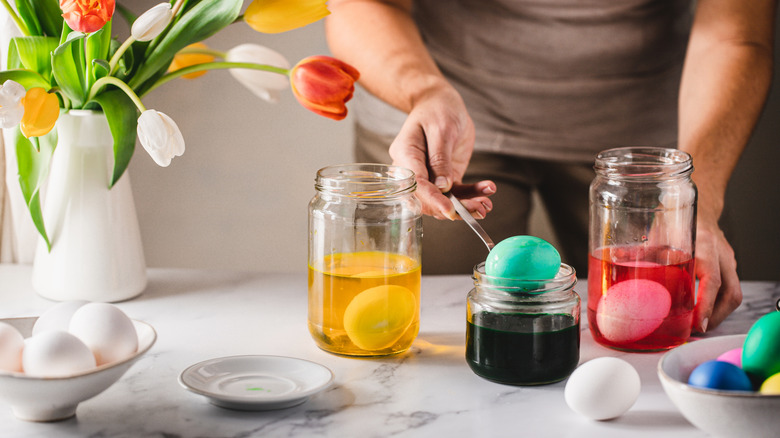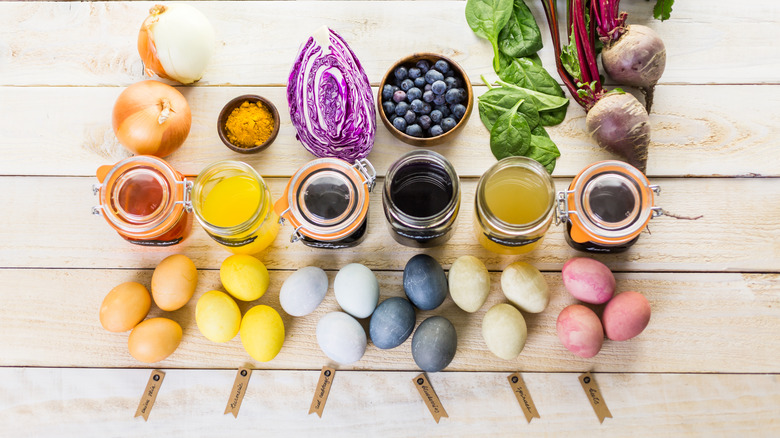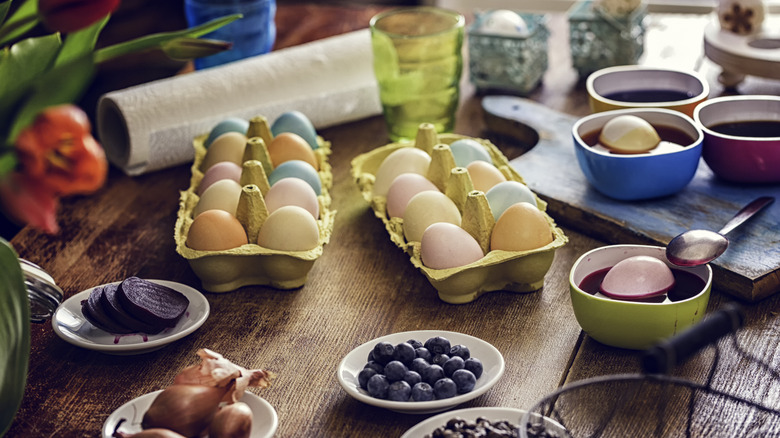The Natural Way To Decorate Eggs For Easter Without Using Dye
Many historians believe the tradition of dyeing Easter eggs dates back to the early Christians in Mesopotamia. The practice is firmly established around many modern dining tables, where families gather to carefully dip hard-boiled eggs into jars that have been filled with dye tablets, water, and a little vinegar to create vibrant colors like ruby red, deep violet, and bright blue. Whether you prefer a short dunk that results in a solid pastel finish, multiple dips for a two-toned or ombre effect, or you get creative with wax crayons or shaving cream to create dye-resistant letters, polka dots, or swirls, there's no denying that the process is one eggs-celent way to decorate your home for Easter. However, there are several inexpensive items in your kitchen you can use if you prefer a more natural way to decorate eggs instead of using dye.
You're probably familiar with PAAS brand dye kits, which have been around since the late 1800s. Although the tablets are labeled as non-toxic and food-safe, research published in the International Journal of Occupational and Environmental Health found that all nine of the U.S.-approved dyes come with health concerns. The Food and Drug Administration (FDA) recently banned Red 3 as a food or color additive, and it's possible that other dyes will be banned in the near future. Fortunately, if you can get your hands on some onion skins, beets, turmeric powder, spinach, parsley, cabbage, or berries, it's easy to put your colorful eggs all in one basket without using potentially harmful dyes.
Use fruit, vegetables, and spices to create natural dye baths
Using natural ingredients to decorate your Easter eggs takes a little longer than using a dye kit. But with some patience, it can produce brilliant results. You'll still want to start with a dozen or more hard-boiled eggs. White eggs work best for dyeing, although you can create a more muted palette by using brown ones. If you've got backyard chickens of your own, and are lucky enough to have Easter Egger chickens in your flock that are laying light pink, blue, or green eggs, you can enhance their color using natural dyes.
While your boiled eggs are cooling, prepare the dye baths. Each natural Easter egg dye starts the same way. Add a quart of water, a dash of salt, and 2 tablespoons of white vinegar to a stove pot. You'll then add chopped fruit, vegetables, or spices to the mix, and allow it to simmer for 20 to 30 minutes. Strain the liquid and allow it to cool. Then, one-by-one, submerge the eggs in the dye baths for at least five minutes.
To achieve red and pink hues, use several cups of shredded beets or red onion skins. Yellow onion skins will result in a bold orange color. If you want to achieve a sunny yellow (that looks more orange when you use brown eggs) add 3 to 4 tablespoons of turmeric. There are several things you can try to achieve deeper jewel-toned eggs. Reduce the amount of water by 1¼ cup and substitute the same amount of vinegar. Use more coloring material. And, soak your eggs for 10 minutes or longer.
Natural plant materials that produce a rich range of colors
If you prefer to give the eggs a green color, starting with 2 or 3 cups of spinach or parsley will produce a light green dye. To achieve a deeper hue, create two separate dye baths: one using 2 cups of purple cabbage, and another using 2 tablespoons of turmeric. Dip your eggs into the bluish cabbage-based dye first, then submerge it into the turmeric yellow bath. You can use just the cabbage dye bath to achieve a light blue color, but make sure you stick to white eggs for the best result.
For a darker blue color, try blueberries instead. Berries are also a good choice if you want your eggs to have a magenta or purplish hue. Mash them first to release their natural color, and consider adding some dried hibiscus flowers to really amp up the color of your dye. If you prefer beige or taupe tones, try experimenting with coffee baths to achieve a variety of browns.
Natural dyes don't just work well on Easter eggs. They're also ideal if you want to personalize linen tablecloths or small woolen gifts you plan to tuck into an Easter basket. If you've got spring fever already, there are also several plants you can put in the garden for natural dyes. Marigold, rhubarb, and hollyhocks are among the plants that can produce a rich range of colors.


